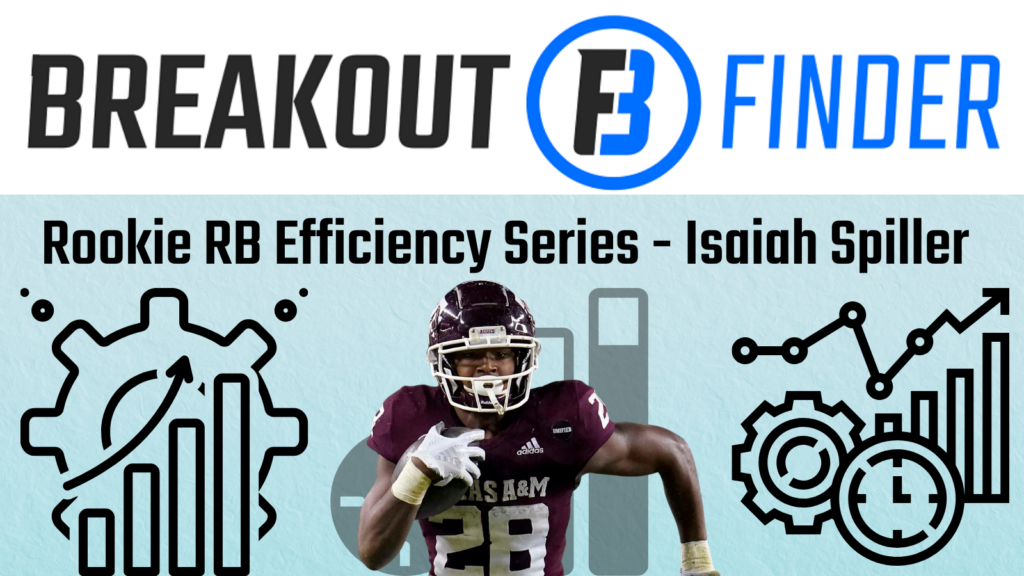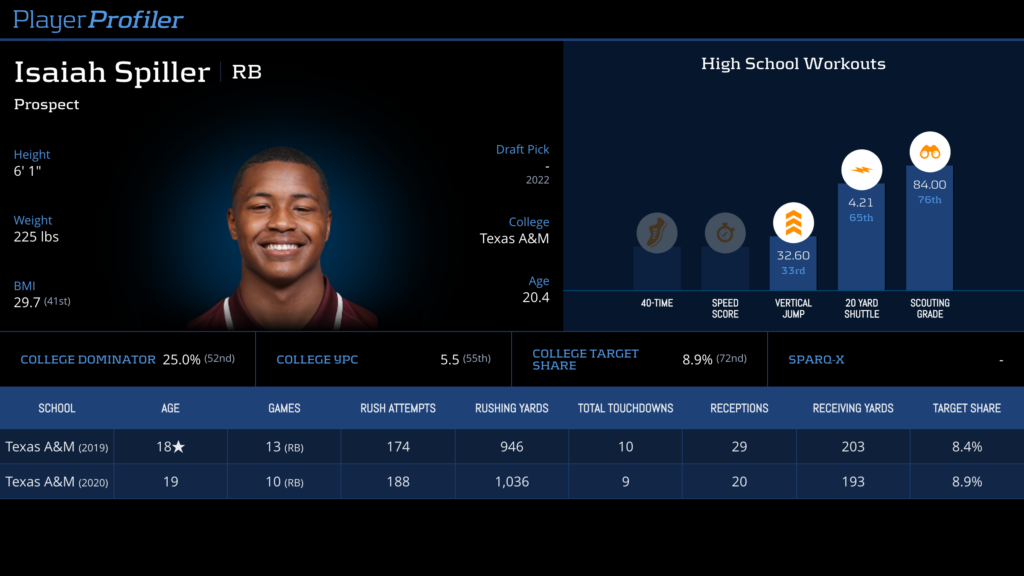
Outside the ability of whoever happens to be running the ball, there is a whole mess of variables that factor into the effectiveness of a given rushing attack; scheme, play-calling tendencies, opponent strength and scheme, weather, offensive line play, surrounding skill-position talent, etc. And given this entanglement, separating the contributions of the ball carrier from the offensive environment in which he operates is not a straightforward task. My approach to answering this question (which, if I were to actually pose it, is something like “how good is this guy at running the ball?”) is centered around measuring the degree to which a running back is over- or under-performing the per-carry output of the other running backs on his team.
Starting from the premise that good runners do more with what they are given than do bad runners, it stands to reason that, provided players are operating under generally the same conditions (like, for example, playing on the same team), better backs should produce more per carry than lesser backs. Using this logic, we can establish a baseline for comparing efficiency between players on the same team; for each running back, we can compare his performance (X) to the collective performance of every other running back on the team (Y). If X > Y (essentially, if dude is doing more with his carries than his teammates are with theirs), we can probably conclude that the player in question is a good player, at least to some relative degree.
Assuming that this is a sound method of evaluating running backs relative to their teammates, we can then extend our comparisons to players from other teams (we’re really just creating a baseline for efficiency comparisons similar to how Dominator Rating and other market share-based metrics create baselines for volume-based comparisons).
The key metrics I use to evaluate running back performance vs. that of their teammates are called Yards Per Carry+ and Chunk Rate+. I also like to use a metric called Breakaway Conversion Rate, but that is not a teammate-relative measure and we’ll therefore look into it separately.
The metrics are pretty straightforward: YPC+ is the degree to which a player over- or under-performs his teammates in yards per carry, and Chunk Rate+ is the degree to which a player over- or under-performs his teammates in rate of “chunk” runs (which I classify as runs of 10 yards or more). At a basic level, I want my running back prospects to find a way to produce more per carry than the other backs on the team, and part of that puzzle is navigating the line of scrimmage and extending runs into the secondary at a higher rate than his backfield mates. YPC+ and Chunk Rate+ measure the degree to which a player does both of these things.

Based on performance in these metrics, the answer to our “how good is this guy at running the ball?” question as it pertains to Isaiah Spiller is: “not very.”
YPC+
Over 541 carries in a three-year career at A&M, Spiller underperformed the average rush attempt by non-Spiller Aggie backs at a clip of 0.73 yards per, giving him a YPC+ mark in the 12th-percentile among running backs drafted since 2006.
An expected retort to this particular analysis is that, for the past two years, Spiller happened to share a backfield with Devon Achane, a four-star recruit out of high school and a dynamic player in his own right who will eligible for the draft in 2023. Is it an indictment of Spiller that he wasn’t outpacing a very talented teammate? Perhaps not necessarily, but I’m not inclined to let him off that easy, for a few different reasons:
1. Spiller is not simply getting outpaced by Achane, he is getting blown the fuck out by him. In 2020, Achane posted 8.47 yards per carry to Spiller’s 5.51, and in 2021 he went for 7.00 while Spiller produced at a rate of 5.65.
2. It’s not just Achane who has outdone Spiller on a per carry rate the last couple years, as teammates Ainias Smith and Amari Daniels have both posted a higher per carry efficiency season, in 2020 and 2021, respectively.
3. In 2019, when Achane was not even on the team, Spiller was the most efficient rusher on the team by a mere 0.03 yards per carry, essentially doing exactly with his rushing attempts what his collective backups were doing with theirs. Further, if you completely remove Achane’s rushes from the 2019-21 team totals, Spiller outpaces his teammates by 0.25 yards per carry, which would be a 39th-percentile showing in YPC+.
Arguments about relief-duty running backs enjoying lighter boxes, having fresher legs, etc., are not completely invalid, but I’m of the opinion that we should be maintaining a high burden of proof on guys we are projecting to the NFL. If a player’s performance does not impress at face value and instead requires justification in the form of excuses, why should I be confident in his ability to succeed at the next level? And even if Spiller did lag behind his teammates because of these confounding factors, other lead runners had the same things working against them too, and among backs who were drafted since 2006 after seeing a per-game college workload at least as large as Spiller’s, 91-percent still performed better relative to their teammates than Spiller did his.
Chunk Rate+
Spiller did not fare much better in the Chunk Rate department. He ripped off 10+ yard runs at a rate 3.18-percent lower than other Aggie running backs during his career, a 14th-percentile mark.
One potentially confounding variable here that I have only indirectly touched on is the talent level of the players that we are comparing Spiller to. If two running backs each outpaced their teammates by 1.50 yards per carry, as Joe Mixon and Danny Woodhead both did in college, surely the more impressive feat was accomplished by Mixon. He proved more efficient than a group of backfield teammates at Oklahoma that boasted an average of 3.87 stars as high school recruits, while Woodhead did so vs. a depth chart of relative no-names at Chadron State.
Spiller’s A&M teammates were a 69th-percentile group based on their 3.72-star average coming out of high school. So it’s not as if these guys that he didn’t quite manage to outdo from an efficiency standpoint were a bunch of scrubs. However, among running backs drafted since 2006 whose teammates’ star ratings were at least 95-perecnt comparable to Spiller’s teammates’ (so between 3.91 and 3.54 stars), the guys to leave college with a YPC+ in the negative are:
C.J. Spiller, Theo Riddick, Paul Perkins, Ben Tate, Baron Batch, Rodney Anderson, Alfred Blue, Chris Rainey, Darren McFadden, Miles Sanders, Mike Gillislee, Ka’Deem Carey, Matt Jones, Jamie Harper, Mike Goodson, Kelvin Taylor, Tashard Choice, Tre Mason, and Daniel Lasco.
The only guys among this group to leave college with a YPC+ lower than Spiller’s -0.73 are Riddick , Batch, Blue, McFadden, Harper, and Mason.
Breakaway Conversion Rate
Let’s now look at Breakaway Conversion Rate, a metric which measures the rate at which a player turns his 10+ yard runs into 20+ yard runs. This essentially gives us an isolated look into a player’s performance once they’ve already navigated the first level of the defense and reached the open field. Spiller’s career mark here is 31.21-percent, a 54th-percentile figure.
At best, he’s fairly average slaloming through the secondary. And a closer look isn’t even quite that encouraging. In 2019, that only season in which he outperformed his teammates on a per carry basis, Spiller posted a Chunk Rate+ mark of -4.03-percent (11th-percentile). This while converting those few 10+ yard runs into 20+ yard runs at a Darrell Henderson-ian rate of 43.48-percent (93rd-percentile). This indicates inconsistent per carry output with passable overall efficiency buoyed by long runs. In 2020 and 2021, Spiller continued to post poor marks in Chunk Rate+ while then failing to deliver big plays at an impressive rate, sitting right around the 25.00-percent mark in BCR (28th-percentile) in each season. Not once did Spiller put together a season’s worth of consistent production on a per carry basis.
Spiller’s composite Rushing Efficiency Score (which accounts for the efficiency metrics touched on above in addition to teammate quality, offensive line yards, and rushing volume) according to my process is 28.4 (out of 100), which is very bad. The good news is that Spiller has a fairly robust profile otherwise. He was fairly productive, he’s big and (presumably) athletic, and he is an asset in the passing game. The other good news is that, for the same reasons that I evaluate running back efficiency in the way that I do, various situational and environmental factors could offer Spiller a chance to be an efficient (or at least productive) player at the next level despite an (apparent) lack of inherent ability. However, I evaluate players and aim to do so in a vacuum as much as I possibly can. And based on what he’s put on wax in the past three years, I cannot endorse Isaiah Spiller as an effective runner of the football. His performance there is bad enough that it worries me for his potential as a contributor to fantasy football teams despite his other strengths.
If Spiller is one of the first five running backs taken in this year’s draft (which it seems a near certainty that he will be), only Tre Mason, Montee Ball, and Christine Michael in the last 10 drafts will have been selected as early in their respective classes as Spiller while also carrying composite Rushing Efficiency Scores below the 30.0 mark. Just as Spiller seems on track for, those eventual NFL disappointments each received substantial pre-draft hype (Rounds 2-3).
Sometimes, dudes who can’t ball just can’t ball.


